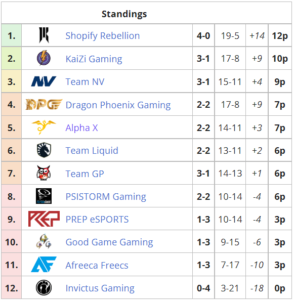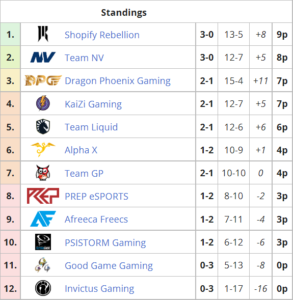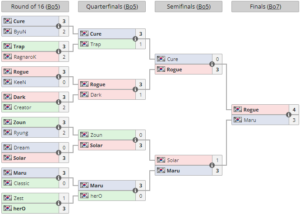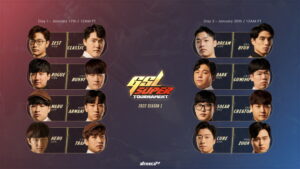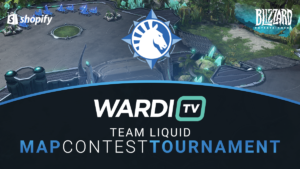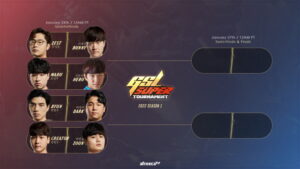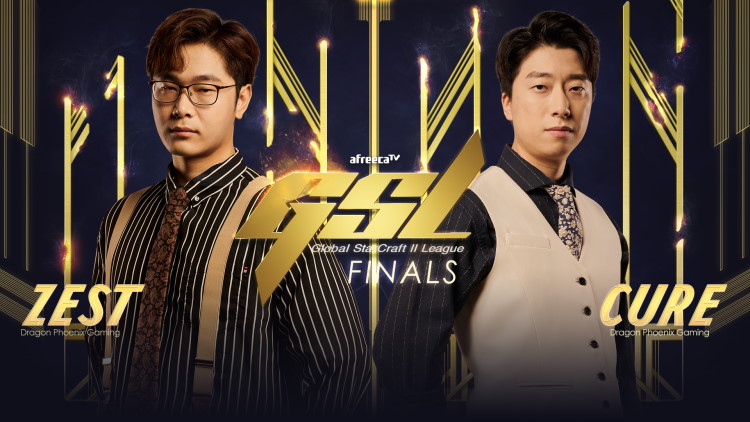
by Poopi and Wax
Match Time: Thursday, Oct 07 9:30am GMT (GMT+00:00)
When the semi-final match-ups were determined, few fans would have predicted this specific finals card.
Rogue was hugely favored against Zest due to his incredible 11-0 record in offline best-of-seven matches, as well as the constant clutch performances he had shown throughout his career. However, the willpower of a departing legend proved to be an even more powerful force, and Zest scored an upset to survive for one final match in his last Code S tournament before military service.
On the other side of the bracket, Cure seemed to be up against a cliffl versus Trap—a top PvT player who had defeated Maru 3-1 in the previous round. Even worse, Cure was in a minor TvP slump in online tournaments, which thrust yet more doubt upon his chances. Instead, Cure’s clever builds and precise execution rattled Trap, and Cure notched his second major PvT win in a row after defeating PartinG in the quarterfinals.
So here we are, with an unexpected but delightful finals card. Zest looks to bow out from the GSL draped in glory and grace, becoming the only player to win his first and last Code S tournaments (shoutout to TL.net users for pointing out this bit of history). Meanwhile, Cure looks to win his first Code S ever, putting a validating capstone on his decade-long journey as a progamer.
It is hard to decide on a favorite for this finals, with both players catching fire in the playoffs and entering the finals riding on a wave of momentum. Both players have an incredibly compelling story as well, and the ending would feel “right” no matter who won.
Still, Zest’s story has to be the more popular one, and for very good reason. Classic used to have the honor of being the player who had the most memorable retirement run, using an audacious DT-Blink build in game five of the BlizzCon 2019 quarterfinals to eliminate Rogue and advance on. Though Classic ended up losing to Dark in the semifinals, the image of him holding his fist up after taking down Rogue has become emblematic of the veteran fighting making one last stand.
However, Zest has already surpassed Classic with his current Code S run, where he’s advanced even a round further to the grand finals. Once again, Rogue was the sacrificial lamb, losing to Zest at the end of an epic and dramatic seven-game series. Not only did Zest advance to the grand finals in the last Code S tournament of his career, but he did it while also ending Rogue’s invincible 11-0 run in offline best-of-sevens. It feels like Zest has already beat the final boss, and the only fitting outcome is for him to win the Code S championship and earn a fairytale ending.
Compared to Zest’s too-good-to-be-true story, Cure’s tale is a much more conventional and common one. But for anyone who understands and appreciates the sacrifices progamers make for our entertainment, it pulls at the heartstrings all the same.
The 10+ year veteran of StarCraft II spent much of his time mired in mediocrity and obscurity, and doesn’t have a single major championship to show for all his efforts. Only in late 2019 did Cure finally break out, evolving from a rumored practice gosu to a title contender in high-stakes events. Yet, a championship has still not come for Cure. He had his best chance in Season 1 of Code S 2020, where he went on a breakout run all the way to the grand finals. However, his finals opponent TY was someone who had already tasted gold in his career, and the difference in experience showed as Cure was beat down in a brutal 0-4 sweep.
It took nearly a decade for Cure to fail to win a Code S championship, and it’s taken him another year and half to earn a chance at redemption. Ironically, he’s done it by becoming much like TY was in 2020—a ruthless, cunning trickster who’s willing to use any underhanded tactic in order to obtain victory. Unlike players who seem to live in major tournament finals, Cure will have full appreciation of how precious this opportunity is. Will that be the pressure on his shoulders that causes him to crumble much more, or the fire that inspires him to his first championship?
Of course, it’s not just the nebulous power of narrative that allowed these two players to meet in the finals. Before Zest ended Rogue’s streak, he was putting in work through all of 2021 to make sure his final year before military service lived up to his legacy as a Protoss legend (Zest has even talked about going back and watching his old games as motivation). The 29-year-old Zest has actually been one of the most prolific tournament players in all of 2021, playing in 1880 games and 635 matches (he may actually be #1 in games played, though we haven’t done a full check of Aligulac). He grinded out games tirelessly in show matches, invitationals, and weekly cups, often participating in all three EPT Cups in a week.
When Zest suffered shock elimination in Code A Season 2 (losing to Parting), he wasn’t discouraged—he seemed to redouble his efforts. Every week, his form seemed to improve, his weaknesses seemed to diminish, and you could see glimpses of the dominant Zest from the past in every match-up. Not only was he playing in all three EPT Cups, but he came close to winning all three EPT Cups in a given week (alas, the triple-crown has eluded him).
Everything has culminated for Zest at the perfect time in the final Code S tournament of the year. Even his losses look like blessings in disguise: he may have lost 2-3 to Dark in ASUS ROG Fall, but it let him avoid Rogue and hide his hand until their more consequential match in the Code S semifinals. Likewise, we might end up looking positive on the fact that Zest has been eliminated early from the latest ESL Weeklies by unheralded opponents such as ProbeScout and Bee—it gives him more time for him to focus on Cure.
Cure, too, has been an extremely active player across various competitions, with over 1400 games played in 2021. However, his return to Code S title contention can be directly connected to his change of approach in the offline arena.
Like Zest, Cure was also the victim of a huge upset in Code A Season 2, where he was swept by RagnaroK after trying to overpower him in straight-up macro games. After the loss, Cure realized that his standard play—as formidable as it was—wasn’t going to be enough. In Season 3, he changed his GSL planning to incorporate far more proxies, cheeses, and all-ins—even against weaker players on paper. This quickly paid off for Cure against his Zerg opponents in the initial rounds, as he earned a return to the Code S playoffs for the first time in five seasons.
Then, in the playoffs, Cure showed this approach worked against Protoss players as well, taking out PartinG and Trap—two of the top three PvT players on Aligulac.com in consecutive rounds. Cure dictated the pace against PartinG with proxy-builds of varying severity, preventing the Protoss player from abusing his signature Blink-Stalker harassment and other micro-intensive forms of aggression. While many fans believed the more solid Trap would fare better, the games ended up following a similar pattern. Perhaps the fans should have remembered that Trap was eliminated by HeroMarine in the previous week’s ASUS ROG, and looked back in history to see what that might portend. Indeed, like at IEM Katowice, Trap crashed and burned and looked frankly lost against Cure, especially after game three where his anti-mine micro rapidly deteriorated over the course of the game.
Being cheesy is the easiest way to become a hate-magnet in StarCraft II, but there’s a certain skill threshold at which the hatred turns into awe and respect (the win-rate of proxy [anything] must be absolutely insane). Cure is now following in the steps of 2018 Maru and 2020 TY, and with one more BO7 victory, he’ll force fans and players to accept that his way is the best way of playing Terran.
Head-to-head and prediction
This is a rather difficult head-to-head match-up to break down, due to the complicated relationship between the two players. As two of the most long-tenured and prolific tournament players in the world, it shouldn’t surprise anyone to hear they’ve played literally hundreds of games against each other. Their all-time match record is a tie at 55W–55L, while Zest leads 201W—190L in maps.
The stats get very intriguing when you look at the more recent results. Cure had a slight lead against Zest up until July of this year, leading 19W–12L in series. However, since August, Zest has been completely dominating Cure in their head-to-heads, winning nine straight matches in various online competitions. Zest basically single-handedly ended Cure’s summer-reign in online cups, even starting the narrative that Cure could be slumping in TvP.
However, as Cure’s victories against PartinG and Trap have shown, stats from online cups can be very deceiving in a Code S context. It’s probably not a coincidence that Cure’s online results started falling off in early August—right as the new GSL season was beginning! In hindsight, the correct narrative seems to be that Cure shifted his focus from online play to the GSL at the appropriate time. Indeed, Cure stopped playing all three ESL Cup servers just before Code A, and stopped playing them entirely as the Code S playoffs were about to begin.
Another complicating factor is that the two players have faced each other plenty of times behind closed doors as well. Cure went out of his way to thank Zest for being his most committed practice partner for his quarterfinal match against PartinG, playing over ten practice maps a day and giving him pointers in the match-up. While the players are likely to have found new practice partners once a finals clash became more realistic, one can’t help but think about the KeSPA-era team-kill matches where players pulled out bizarre openers we’d never see between ‘normal’ opponents. Zest and Cure were always going to rack their brains for a strategic advantage, regardless of the opponent—but now we might see them attempt to pull off even more risky and creative mind-games than usual.
Cure’s preparation has been on-point so far, but it’s slightly concerning that he’s had to show his hand in nine games already. On the other hand, Zest barely showed anything special in his quarterfinals victory against Dream (3-1), winning with solid all-around play. One must wonder what else Cure has left in the bag that could surprise Zest—he did mention that he saved his more unorthodox builds for the latter half of the Trap series and thus didn’t get to show them.
In prior previews, we’ve talked about how it can be dicey to use top Protoss players as stand-ins for each other. Thus, Cure’s success at disorienting Trap doesn’t necessarily mean he can do the same against Zest. Even so, being able to crack Trap’s defense is much more easily said than done (just ask Maru), so it’s more a credit to Cure’s build order preparation than indictment of Trap’s defense.
All-in-all, this seems like a match-up where the big picture stats could be especially irrelevant, but it’s still interesting to go over them as a baseline reference. Zest’s overall PvT record in 2021 stands at an impressive 462W–241L (65.72%) in maps and 158W–61L (72.02%) in matches, while he’s 4-0 matches/11-2 maps in offline competitions (admittedly a tiny sample).
Cure has slightly better all-around stats, posting a 463W–239L (65.95%) record in maps and 166W–52L record in matches (76.15%, which +4.13% over Zest). Going off offline series alone, he has a similarly limited sample, going 2-2 in matches and 8-8 in maps (funny enough, he lost to both PartinG and Trap in earlier Super Tournaments, but then demolished them in this GSL).
Aligulac also seems to think that these two are almost evenly matched, but still gives the slight edge to Zest with a 54.28% chance to win. Cure’s dismissal of highly rated Protoss players PartinG and Trap have helped him secure fourth place on the statistics website’s TvP rankings, but Zest’s own beatdowns of Cure in online cups have helped him reach #1 in the PvT rankings.
The final prediction ultimately goes in favor of Zest, but not due to any of the conventional statistics—GSL-Cure has already proved that he can play at a higher level than the numbers predict, and has taken down the #2 and #3 PvT players in the world. However, Cure is still not a Code S champion or major tournament champion, and he’s yet to pass the ultimate test of nerves in a grand finals. It’s hard to believe something until you’ve seen it, and even with two great victories against PartinG and Trap in the bag, it’s hard to give Cure the vote of confidence that he has a championship-level mentality. Even though it’s been over a year, the memory of his crushing defeat to TY resonates slightly more than his recent triumphs.
This is not to say that Zest is a paragon of consistency, as he’s suffered his own share of bad finals defeats. He lost his last Code S finals in one-sided fashion to a dominant 2018 Maru, and he also has the dubious honor of being the two-time defending IEM Katowice runner-up. But even after adding those runner-up finishes in the latter half of his career, Zest has still won more gold than silver (six to five), has far more experience than Cure in playing in a grand finals setting, and knows what it takes to win a championship.
Rogue vs Zest seemed like it would be close before the matches, and faith helped tip the prediction over to Zest’s side. Here, we’ll do it again. In 2014, Zest walked the Royal Road. He’s followed that road all the way around, only to discover it’s led back to the same place. Winning his final Code S wouldn’t just conclude one of the greatest stories in StarCraft II, but it would cement Zest as the undisputed greatest Protoss player of all-time. The finals might go without an audience, but fans will feel a deafening chorus “Zest is best” in their hearts.
Prediction: Zest 4 – 2 Cure
Source: https://tl.net/forum/starcraft-2/579003-code-s-season-3-zest-vs-cure-grand-finals
